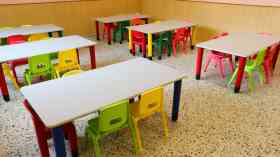Healthy bodies, Healthy minds
A school is essentially a child’s ‘workplace’, and as such, the application of ergonomics should be applied to fulfil health and safety obligations. But this is often not the case, finds Levent Çaglar, senior consultant ergonomist at FIRA
Ergonomics is the study of the interaction between people and their environment. Good ergonomic design seeks to modify the environment and activities to enable people to carry out their tasks more effectively, healthily and comfortably. The lack of application of ergonomics in analysing the activities in schools and using this to inform the design of the buildings and the choice and use of furniture has detrimental effects on children’s wellbeing and learning.
For too long, we have failed to recognise schools as children’s workplaces. We have not appreciated the importance of the application of ergonomics to this workplace in order to improve children’s wellbeing and productivity which in educational terms is better learning and greater achievements. Application of ergonomics to schools could improve schools’ standing in the league tables.
Treating schools as a workplace
We know the impact of un-ergonomic workplaces and furniture for adults in terms of productivity and wellbeing, including development of musculoskeletal disorders and increased absence from work. If we continue to provide un-ergonomic workplaces and furniture for children, as they spend more time being sedentary than did previous generations. They will be less fit and have less productivity when adults. The high proportion of children with back problems already will increase the future proportion of adults taking time off work, increasing the cost to the economy.
Studies in several countries have shown that similar increases in back pain from around 13 per cent in children aged 12-16 to adult levels of around 30 per cent aged 15-19.
(Burton et al 1996, Jones et al 2001, Le Resche et al 2005). Eight per cent of all 15-18 year olds had recurrent or chronic lower back pain (Jones et al 2004). People who experience back pain as teenagers are much more likely to have back pain as adults. (Croft et al 2001, Harreby et al 1999).
A breach of health & safety
Children often spend over 10,000 hours in the school (their workplace) sitting on un‑ergonomic furniture, working in un-ergonomic environments with stale air and spending much too much time in static postures.
If these conditions existed in office environments they would violate the Health and Safety (H&S) regulations. But as these H&S regulations do not apply to children; these unsatisfactory conditions are allowed to continue. For example, children are often sitting on ill-fitting chairs which impede their circulation and require them to twist their backs to see the teacher. Also, the lack of storage space may result in children carrying heavy back packs full of books and equipment which can initiate injury to their back, giving them back pain from an early age.
Numerous studies show that the application of ergonomics in the adult workplace in the last 20 years has improved productivity, efficiency and wellbeing. This has been achieved mainly through ergonomic furniture, equipment, environments and task design
What is the current state of schools?
Many school buildings are relatively old and ergonomics played no part in their design. Only a very small fraction of furniture used in schools has been designed or selected based on ergonomic principles. There is little ergonomic design of layouts of learning spaces and furniture.
Teaching methods generally force children to work in static unhealthy postures and teachers often associate movement with misbehaviour and ask children to sit still and not move. Static cramped postures decrease circulation and oxygen intake and flow to brain which inevitably lowers alertness. Children spend far too long adopting such postures, so become tired, bored and fidgety. To increase alertness and productivity, children need to be able to adopt healthy dynamic postures.
In order to promote healthy movement, schools need to take broader account of the link between healthy bodies and minds. They need to go beyond increasing healthy eating and promoting bouts of exercise, such as brain gym. The environment, furniture and teaching activities need to allow natural movement and healthy postures throughout the day. If we were to give posture training to children at a young age, maybe they would not develop bad sitting habits.
To get children to adopt dynamic postures, children need chairs that allow them to rock or recline a little, or turn round to talk to others or watch as the teacher moves. However they need to be able to do this safely. At present, many children lean back dangerously on their static chair four legged chairs, often being reprimanded by their teacher.
Progress in schools
In the last decade there have been some improvements in the application of ergonomic principles in schools, mainly to the buildings themselves, such as increasing circulation space, or improving ventilation and natural lighting. Building Schools for the Future (BSF), was one step towards designing better working environments. As BSF scheme no longer exists, the application of ergonomics to school environment could decrease.
A number of studies mainly from Germany, show that ergonomic intervention in schools improves children’s ‘productivity’ through improving: their behaviour concentration and attentiveness. For example, a test group which had movement built into their daily activities in the school and used ergonomic furniture promoting movement, reduced static sitting to three per cent from 61 per cent
(source: Breithecker 2005). The same study also found that giving children increased opportunities to move through seating which promotes rocking, swivelling or rolling and through planning teaching that builds in movement between workstations, some of which require standing, resulted in higher levels of attention and concentration in comparative tests.
The maths
Currently in the UK, the most commonly purchased combinations of table and chair cost about £30, less than the price of a pair of trainers that we only expect a growing child to use for one year. We expect to use the furniture for about 10 years, which is almost as long as a child spends at school. In other words, we are prepared to spend £3 per year per child on furniture, Often such combinations of table and chair are uninspiring, uncomfortable and unhealthy furniture. They can limit children’s learning capabilities by forcing them to adopt postures where their abdomens and chests are compressed, reducing their oxygen intake and consequently restricting the supply of oxygen to their muscles and brain. This makes their limbs feel tired and their brain less alert. It inhibits their learning and may affect their healthy growth.
Our Northern European cousins spend 3-4 times as much on school furniture as we pay in the UK. Not surprisingly, European children have much better furniture which is exciting, durable, safe, ergonomic and back-friendly. This is a key factor in better academic achievement. We are prepared to provide fantastic new school buildings and facilities, but we carry on furnishing them with inappropriate under funded furniture.
Levent Çaglar, FIRA’s chief ergonomist has been working with the Department of Education and its forerunners since the late 80s. In numerous studies he has undertaken for the department during this time he has shown that the furniture being used in schools did not match the sizes of the children and forced them to adopt un-ergonomic and unhealthy postures. The introduction of computers in schools has been rapid but insufficient consideration has been given to the furniture on which these were placed and the seats children were sitting on.
Mismatched furniture in terms of size can cause excessive slouching or prevent the child’s feet from touching the floor, thereby restricting the blood supply to their lower legs and feet. This combination leads to the child becoming restless and fidgety in class, resulting in a decrease in concentration as the lesson progresses and an increase in disruptive behaviour. Bad furniture can lead to bad posture, which if sustained over long periods can lead to musculoskeletal disorders such as back ache, neck and shoulder ache or pain. Any damage to a child’s back that occurs in their youth is very likely to cause them to suffer from back pain later in life.
In conclusion, we should apply ergonomics principles in schools in the same way we do in offices. Ergonomists should work with educators and children in the design of buildings, and the selection and layout of furniture and equipment, always considering the needs and aims of the schools, children and teachers. This will increase children’s achievements, improve their behaviour and wellbeing. Children with healthy backs will reduce the likelihood and severity of back pain they might suffer in their adult lives.
Further information
www.fira.co.uk
Latest News
19/12/2025 - 09:54
The Education Committee has expanded its ongoing inquiry into the early years sector to examine how safeguarding can be strengthened in early years settings.
18/12/2025 - 09:25
The UK will be rejoining the Erasmus programme in 2027, following a package of agreements with the EU.
17/12/2025 - 09:31
Ofqual has fined exam board Pearson more than £2 million in total for serious breaches in three separate cases between 2019 and 2023 which collectively affected tens of thousands of students.
16/12/2025 - 09:19
The average funding rates will increase by 4.3% for under 2s, and by almost 5% for 3-and-4-year-olds.
15/12/2025 - 10:30
Local colleges are set to receive £570 million in government funding to expand training facilities in areas such as construction and engineering.







